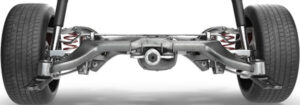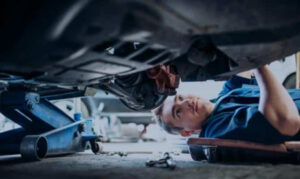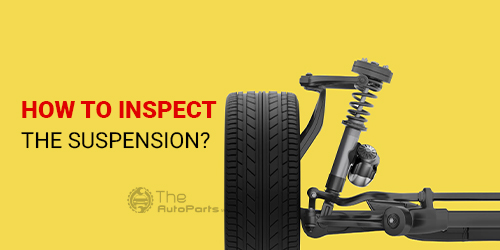Identifying suspension issues has been easier than ever, and the issue can be determined from your way of driving. However, if you want to get the surety that the issue is exactly what you are thinking, jack up the car and inspect the components. Numerous symptoms accompany a problematic suspension system, and each one of them has been highlighted in the article in the subsequent paragraphs:
Signs of Suspension Problems

During suspension problems, the driver will encounter the following issues:
Be Cautious of the Rough Ride
Over time the suspension components start wearing out. After inspecting these components thoroughly, you’ll know that the components have been compromising a lot. One of the best ways to identify suspension issues is how you drive. The ride has started getting tough, and cannot absorb the bumps the way it’s supposed to be.
- If you’ve been noticing more bumps and shakes while driving, the suspension has an issue. Take your car to the mechanic as the vehicle needs suspension replacement to fix the issues.
- At times tough ride is accompanied by audible squeaks, and managing the bumps on the road becomes a hassle for the suspension.
Check Vehicle Pulls or Squeaks While Turning It
If the vehicle has started moving in the direction opposite to the turns, it is because the suspension has failed. Different components affect different vehicle regions, including the steering response, angle of the tires, and center balance of the car. This makes turning impossible or an arduous task for you. Sometimes the issue gets so worse that it makes the low ball joint bad.
- Ensure that the vehicle’s response to the turns is thoroughly inspected and compare your past experiences to check whether it is a serious issue or not.
- Monitor cautiously to see whether the components of the suspension are squeaking under pressure or not.
- Each vehicle behaves differently as you turn them, so compare the past experiences & carry out suspension inspection and maintenance thoroughly.
Check the Tread Wear of Your Tires
The tires must wear fairly across the width of the tread. Sometimes you would see that the area within or outside the tires begins degrading quickly. It is possibly due to camber issues in the wheels and tires.
- A car with negative camber makes the tire wear rapidly.
- In the case of positive camber, the exterior region of the tires would start degrading quickly.
- Camber can be determined from the car’s suspension components and the alignment of the wheels.
Try Stopping The Car Quickly To Check The Noise Dives
If you’ve been experiencing issues with the front struts or shocks, keeping the vehicle level under hard braking is impossible. Instead, park the car in a safe area & look at the front of the vehicle. If the nose of the car dives or drops as you stop the car, it is possibly due to a shock or strut issue.
- The car’s weight is generally taken care of by the suspension, and keeping it at a fair level is difficult in most cases.
- The front corner of the car starts dropping as you turn it. Suspension failure is the prominent cause of the issue, and suspension replacement would resolve the issue in no time.
Check it in Case it Sways or Bounces
Handling the bumps on the road mustn’t be a hassle for your car. However, if you go over a bump and notice swaying or bouncing in your car, the car’s suspension cannot deal with the car’s weight.
- Your vehicle must be able to move over the bump & get the composure again at low speeds.
- If you have been noticing the swaying or bouncing issue carry out the suspension inspection and get a new one in case of issue.
Heading Towards the Front Suspension
Perform Visual Inspection of the Strut Mounts or Shock Towers
Open the hood and check either side of the car. The shocks or struts stretch to the Fender above the wheel and are kept intact by several nuts or bolts.
- If the struts or mount isn’t secured properly, working properly becomes an impossible task for them.
- Rust makes you compromise on the nuts as well as parts themselves.
Check the Ride Height of Your Front Wheels
Take a ruler or tape to determine the length of space between the tire’s top and bottom of the Fender, which is the driver’s side of the car. Carry out the same process on the passenger’s side to notice any difference.
- If you notice that the aside is lower, the problem is.
- If both sides are even, there might be suspension affecting both sides equally.
Inspect the Grease Boots or Rubber Bushings for Damage
Get below your car, start with a single wheel, and take a look at the rubber bushings segregating the metal components of suspension from one another. Mostly they are black and become grey as time passes.
How Much Does Suspension Replacement Cost?

The suspension replacement cost is generally affected by the car’s make, year, and model, along with the car parts that need to be replaced. The quality of car suspension also affects the price of the suspension. These costs burn a hole in your pocket, so it would be best to purchase online car parts and accessories from a trusted store like ‘The Autoparts Shop‘ & save money.
The Bottom Line
Driving a car with a problematic suspension is a hassle for many. Take the car to a qualified mechanic for proper suspension inspection and maintenance. You can save money by getting the suspension from the customer’s trusted car parts and accessories store ‘The Auto Parts Shop,’ delivering products within a day.
